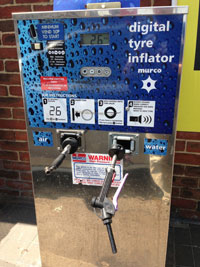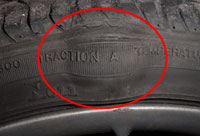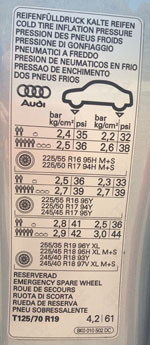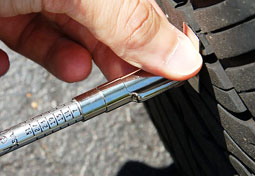Tyre Pressures
The AWD Guide to Tyre Pressure and Maintenance
 Ensuring that your tyres are set to the correct pressure and are in good condition is an essential and often overlooked part of the basic maintenance routine that should be carried out on your vehicle. At a minimum tyres should be checked on a weekly or fortnightly basis, with more frequent checks for long journeys – for instance if you’re planning on a long drive you should always check your tyres for damage and check the pressures before setting off.
Ensuring that your tyres are set to the correct pressure and are in good condition is an essential and often overlooked part of the basic maintenance routine that should be carried out on your vehicle. At a minimum tyres should be checked on a weekly or fortnightly basis, with more frequent checks for long journeys – for instance if you’re planning on a long drive you should always check your tyres for damage and check the pressures before setting off.
At the bottom of the page we have included a free tyre pressure tool to give you the recommended pressures for your car based on the model and tyre size. This is a guide only; please ensure you consult your vehicle handbook for more accurate information.
Why are tyre pressures so important?
Tyre pressures determine how much of the tyre is in contact with the road surface – and this directly affects steering, handling and braking performance.
Tyre pressure affects:
- Braking, steering, handling and safety.
- Fuel economy
- Tyre wear; how quickly your tyres last and how evenly they will wear.
Regular pressure checks will:
- Ensure safety
- Reduce costs
- Help monitor for slow punctures
Over inflation: If your tyres are overinflated a smaller area of the wheel (the centre) will be in contact with the road surface. This increases your overall braking distance (it will take you longer to stop) and causes your tyres to wear unevenly – the centre of the tyre will wear more quickly than the outer edge and your tyre’s life will be reduced.
Under inflation: Underinflated tyres affect braking performance, reduce fuel economy and also increase the risk of a blowout. As the vehicle corners, an underinflated tyre will roll onto an area outside of the tyre tread increasing the heat within the tyre. This has the potential to cause a blowout and the underinflated tyre will reduce steering performance.
Checking Your Tyres
When you check your vehicle’s tyre pressures it’s also important to check the overall condition of the tyres, looking for any scuffs, bulges or damage to the tyre wall (the side of the tyre) and the tread depth (see below).  If any damage is visible, fit your spare wheel or space saver and get the tyre replaced or inspected at a tyre centre. Checking for tyre damage is just as important as checking the pressure. Bulges, scuffs or cracks can lead to a blowout whilst driving, which can be extremely dangerous – especially at speed. Regularly checking your pressures will also help you monitor for punctures. If you’ve got a slow puncture you’ll soon notice that the pressure keeps dropping on a particular tyre, even though you keep topping it up – regular checks will help you pick up slow punctures more quickly, before they become a problem.
If any damage is visible, fit your spare wheel or space saver and get the tyre replaced or inspected at a tyre centre. Checking for tyre damage is just as important as checking the pressure. Bulges, scuffs or cracks can lead to a blowout whilst driving, which can be extremely dangerous – especially at speed. Regularly checking your pressures will also help you monitor for punctures. If you’ve got a slow puncture you’ll soon notice that the pressure keeps dropping on a particular tyre, even though you keep topping it up – regular checks will help you pick up slow punctures more quickly, before they become a problem.
Every vehicle has a set of recommended pressures for the front and rear wheels that are provided by the vehicle manufacturer. On many vehicles the recommended front and rear tyre pressures will be different, and there will also be a set of pressure recommendations for a full load (lots of passengers and luggage) or a half load (one or two people). Tyre pressures will also depend on tyre sizes, engine position and vehicle dynamics. For most vehicles you can find the recommended pressure settings on a label inside the drivers door, on the back of the petrol cap or in the vehicle’s handbook. We’ve also included a handy tyre pressure tool below to act as a guide. Remember: Tyre pressures should be checked when the tyres are cold – before setting off. 
Air pumps for checking pressures are widely available at petrol stations, garages and from automotive resellers. Most petrol stations provide digital inflators that allow you to set a target pressure in PSI or BAR. Once the pump’s nozzle has been attached to your tyre valve it automatically inflates or deflates the tyre until it reaches the desired pressure. Automotive resellers sell portable electronic pumps that work in a similar way and can be plugged into your vehicle’s cigarette lighter.
Tyre Pressures – PSI Vs. BAR
Traditionally tyre pressures were measured in PSI, or pounds per square inch, which is based on the imperial system of measurement. Over the years there has been a gradual shift away from using PSI as the primary system of measurement towards BAR pressure. Whilst many car manufacturers still give their pressure settings in PSI, European manufacturers have tended to use BAR either in addition to, or instead of, PSI. PSI primarily exists for the American market where imperial system of measurement is still dominant. German car manufacturers including BMW, VW Audi, Porsche, Mercedes and Mini, primarily use BAR – and on some vehicles it is the only measurement that will be quoted for their vehicles. Fortunately in the UK most pumps and gauges use both systems, automatic pumps at petrol stations can easily be switched between the two.
Tyre Tread Depth
 It is also very important to check your tyre’s tread depth whilst you are checking tyre pressure. If the tyres are correctly inflated and the tracking is correctly adjusted the tread should wear evenly across the tyre. The more miles you drive the lower your tread depth will become. In the UK the minimum tread depth for a passenger vehicle (excluding motorcycles is 1.6mm. This is measured across the centre ¾ of the tread around the entire circumference of the wheel.
It is also very important to check your tyre’s tread depth whilst you are checking tyre pressure. If the tyres are correctly inflated and the tracking is correctly adjusted the tread should wear evenly across the tyre. The more miles you drive the lower your tread depth will become. In the UK the minimum tread depth for a passenger vehicle (excluding motorcycles is 1.6mm. This is measured across the centre ¾ of the tread around the entire circumference of the wheel.
Although this is the legal minimum it is worth remembering that your vehicle’s breaking performance will start to decrease once the tread depth drops below 3mm – many police forces change their tyres at 3mm. It’s good practice to think about changing your tyres at or at least 2mm.


